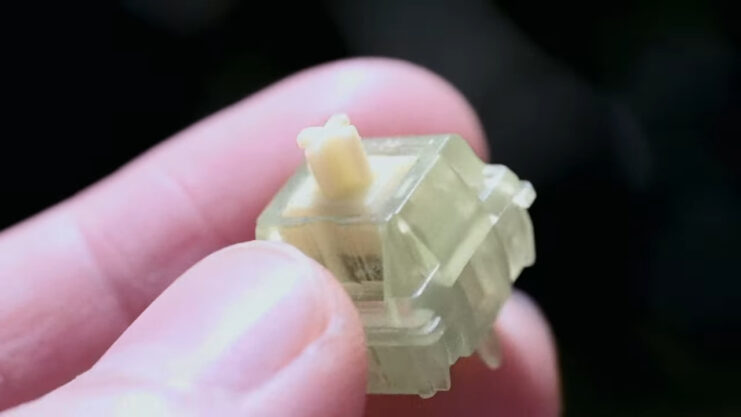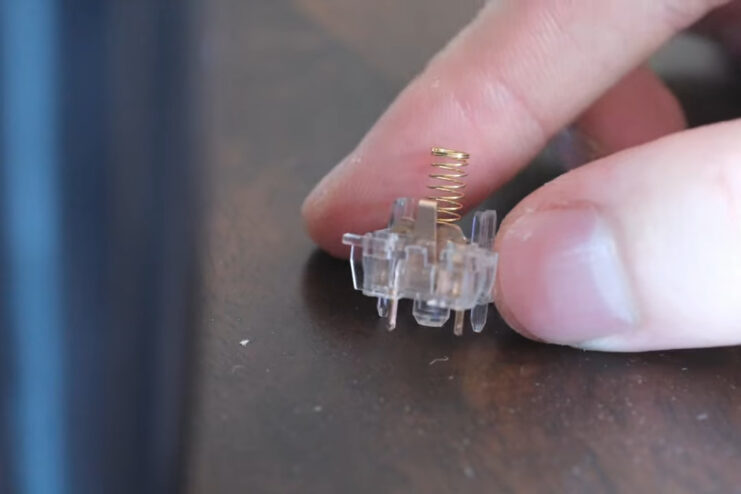Mechanical keyboards have revolutionized the way we interact with our computers, offering a level of responsiveness and tactile feedback that membrane keyboards simply can’t match. At the heart of this revolution are the switches under each key, which define the keyboard’s feel and performance.
Among the most popular types are linear and tactile switches, each offering a unique typing and gaming experience.
Therefore, it is a must to address several things:
- Distinct characteristics of switch types
- Popular variants and customization
- Use case and personal preferences
That is why we’ll go through their features, benefits, and which might be the best fit for your typing or gaming needs.
Comparative Analysis of Linear and Tactile Switches
For you to make the best possible decision, it is a must to see the differences and similarities between linear and tactile switches.
| Feature | Linear | Tactile |
|---|---|---|
| Keystroke Feel | Smooth and consistent | Slight bump during actuation |
| Tactile Feedback | None | Yes, noticeable during keypress |
| Sound | Generally quieter | Quiet with tactile feedback |
| Speed | Preferred for rapid keypresses | Slightly slower due to bump |
| Accuracy | Consistent but lacks physical feedback | Physical feedback aids in accuracy |
| Best For | Gaming and scenarios requiring quick actions | Typing, programming, and detailed work |
Linear Switches

Linear switches are renowned for their smooth, consistent, and silent keystroke. These are a favorite among gamers who value speed and an uninterrupted typing experience.
Unlike their tactile counterparts, linear switches lack a noticeable bump, providing a seamless experience from the moment of actuation to bottoming out. This feature makes them ideal for scenarios where rapid keypresses are crucial, such as in fast-paced gaming.
Popular linear variant includes the Jelly Black, known for its heavier feel, and the Akko CS Silver, favored for its short travel time and almost instantaneous response. Budget-friendly options like the Gateron Milky Yellow provide an accessible entry point into the world of linear switches, while classics like the Cherry MX Reds remain a steadfast choice for many.
Lubing, or lubricating, these can significantly enhance their performance. It reduces any scratchy sensations and ensures a smoother keystroke, elevating the overall typing experience. For those who prefer a ready-to-use option, pre-lubed switches like the Akko Linear Black are available, offering convenience without compromising on quality.
Tactile Switches

Tactile switches offer a different kind of typing experience, characterized by a noticeable bump or tactile feedback during each keypress. This feedback provides both an auditory and physical cue, signaling that the key has been activated.
Such a feature is particularly beneficial for touch typists and professionals like writers and programmers, who rely on quick and accurate typing. Notable tactile options include the Cherry MX Brown, offering a balanced actuation force, and the Cherry MX Clear, known for its slightly heavier feel.
Gateron Browns are another popular choice, providing a similar experience with a distinct feel. Despite some misconceptions, tactile switches are not inherently slower or less accurate than linear switches.
The actuation force and travel distance can vary significantly among different models, debunking the myth that tactile switches are universally heavier or have longer travel distances.
Personal Preference and Use Case
When choosing between linear and tactile switches, personal preference and specific use cases play a pivotal role. Linear switches, with their smooth and consistent keystroke, are often the go-to choice for gamers.
| Use Case | Linear | Tactile |
|---|---|---|
| Gaming | Ideal for fast-paced, action-heavy games | Suitable for strategy and games requiring deliberate actions |
| Typing | Preferred by those who value smooth keystrokes | Favored for tactile feedback aiding in speed and accuracy |
| Programming | Suitable for long coding sessions | Preferred for tactile feedback and error reduction |
The Gamer’s Preference
Linear switches are celebrated for their smooth and consistent keystroke, making them a preferred choice among the gaming community. The key feature here is the absence of a tactile bump. This smoothness allows for rapid, uninterrupted keypresses, a crucial factor in fast-paced gaming environments where every millisecond counts.
The consistent pressure required to activate each key means gamers can maintain a rhythm, crucial in scenarios requiring quick reflexes and sustained rapid keypresses, such as in first-person shooters or action games.
The quieter nature of linear switches is a boon for streamers and gamers in shared spaces. The reduced sound output minimizes distractions, allowing for a more immersive gaming experience and less disturbance to others.
Typists and Strategy Gamers

Tactile switches, characterized by their noticeable bump during actuation, are often the go-to for typists and enthusiasts of RTS (Real-Time Strategy) games. This tactile feedback is more than just a physical sensation; it’s a form of communication between the keyboard and the user.
It signals that a keypress has been registered, allowing the typist to move on to the next key without fully bottoming out. This can lead to a more efficient typing experience, reducing fatigue and increasing speed, especially beneficial for professions that involve heavy typing, like writing or coding.
In the context of RTS and other strategy-based games, this tactile feedback provides a distinct advantage. It allows gamers to execute commands quickly and accurately, ensuring that each keypress is deliberate and precise. This can be particularly beneficial in games where strategy and timely execution are paramount.
Speed vs Feedback
The choice between linear and tactile switches often comes down to a balance between the need for speed and the desire for feedback.
Linear switches, with their uninterrupted travel, are all about speed and fluidity, making them ideal for scenarios where rapid keypresses take precedence.
Tactile switches, on the other hand, offer a level of feedback and assurance with each keypress, an essential feature for tasks requiring precision and accuracy.
FAQs
Do tactile switches wear down?
Yes, like all mechanical switches, tactile switches can wear down over time, but they generally have a long lifespan, often rated for tens of millions of keypresses.
Is linear or tactile quiet?
Linear switches are typically quieter than tactile switches because they lack the tactile bump that can produce additional noise. However, the overall noise level also depends on other factors like the keyboard design and whether the switches are lubricated.
Do pros use linear switches?
Many professional gamers prefer linear switches due to their smooth keystroke and rapid actuation, which can be advantageous in fast-paced gaming. However, switch preference is highly subjective and varies among individuals.
Are Razer switches linear or tactile?
Razer offers both linear and tactile switches. For example, Razer’s Yellow switches are linear, offering a smooth keystroke, while their Orange and Green switches are tactile, providing a noticeable bump during actuation.
Summary
The choice between linear and tactile switches boils down to personal preference and the specific requirements of your typing or gaming activities.
While linear switches offer speed and a smooth keystroke, tactile switches provide valuable feedback for each keypress, enhancing accuracy and typing experience.
Therefore, your needs will be the ultimate factor that will help you with making the best possible decision.

